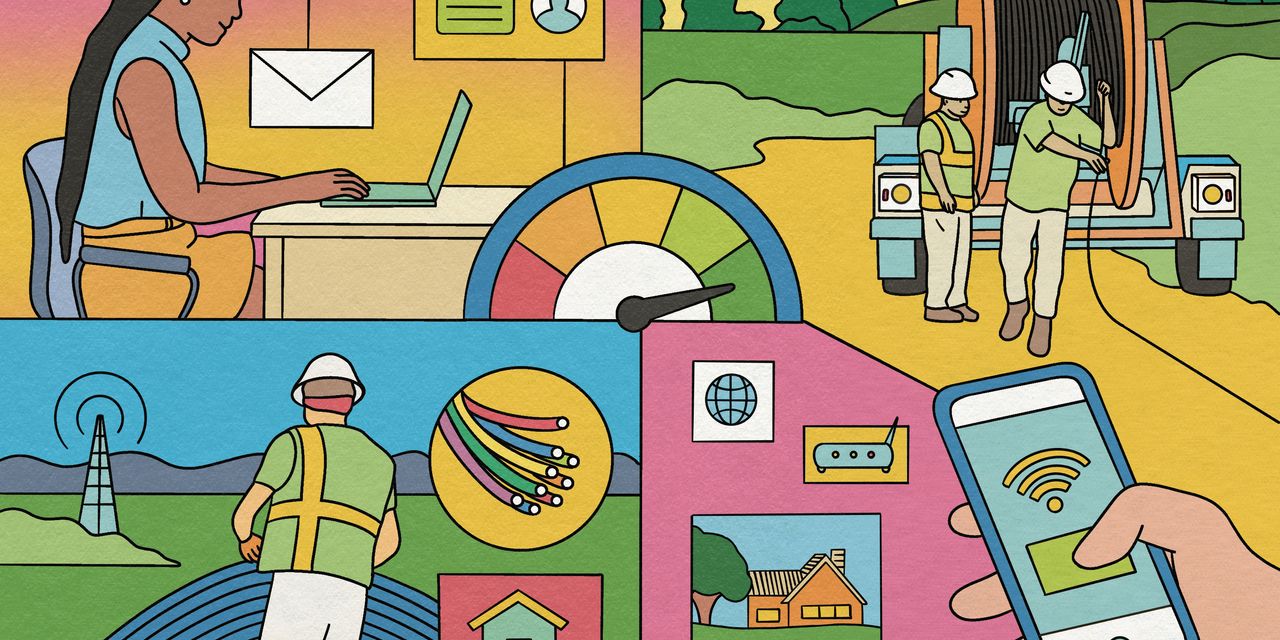That’s
Frontier Communications
’ (ticker: FYBR) motto in its latest iteration, following a tumultuous few years that included bankruptcy, a pandemic, and pressure on older telecommunications technologies. With a new management team and a refreshed balance sheet, its stock looks attractive as Frontier progresses toward its goal of 10 million fiberoptic locations connected to its network.
Life hasn’t been easy for Frontier shareholders. The company filed for bankruptcy just over three years ago, wiping out the equity and some $11 billion in debt. Armed with a new balance sheet, Frontier is upgrading its network to fiber from copper. That’s capital-intensive—a turnoff to growth investors—and requires burning cash—discouraging value seekers. Its shares, at a recent $14.31, have dropped 42% over the past 12 months,
Extending fiber to millions of homes by digging up streets or climbing telephone poles won’t happen overnight, but it will happen. Frontier is more than halfway to its goal after adding 339,000 fiber locations in the first quarter. It’s getting more profitable with each fiber customer added, while pruning costs. Frontier might not be the most exciting story, but it does have a clear plan that should pan out.
“We’ve got a very simple strategy: Build fiber, sell fiber, improve care, reduce cost,” CEO Nick Jeffery said at a conference in late May.
| Headquarters | Norwalk, Conn. |
|---|---|
| Recent Price | $14.31 |
| 52-Wk Change | -41.9% |
| Market Value (bil) | $3.5 |
| 2024E Sales (bil) | $5.8 |
| 2024E Net Income (mil) | -$29.7 |
| 2024E EPS | -$0.11 |
| 2024E P/E | N/A |
E=estimate; N/A=not applicable
Source: Bloomberg
If the old Frontier was stuck in the past, offering internet over slow copper wires, the new one is racing to build out its high-speed fiber network. The $3.5 billion market-cap company has nearly three million broadband internet subscribers across 25 states, on a network that reaches about 5.5 million homes and businesses via fiber and another 10 million via copper. About a third of Frontier’s potential fiber customers subscribe, three times the rate of those on copper lines.
Building out its fiber network will cost more than Frontier’s management forecast when the company emerged from bankruptcy in early 2021. Its latest two million locations cost an average of $830 to hook up. In May, management said it expects the remainder of this year’s build to cost between $1,000 and $1,100 per location. It costs Frontier another $600 or so to send a technician to a customer’s home to plug in all the necessary equipment and the like.
Yet even at the higher cost, the math works. Frontier says that 85% of its footprint has only one or no broadband competitor, helping to boost penetration, or the percentage of connected locations that actually subscribe, and average revenue per user, or ARPU. Frontier expects to reach penetration of at least 45% within a few years of extending fiber to a new market at a monthly ARPU of around $67.50, which it can increase by 3% to 4% annually.
Frontier still has debt, but it is manageable, particularly for an infrastructure-heavy telecom company with plenty of real assets to borrow against. After a first-quarter debt raise, it now has $7.8 billion of net debt on its balance sheet—for 3.7 times net debt to earnings before interest, taxes, depreciation, and amortization, or Ebitda, at the end of that quarter.
Charter Communications
’ (CHTR) net leverage stood at 4.5 times at the end of the first quarter, while
AT&T’s
(T) stood at 3.2 times. Frontier’s debt doesn’t mature until 2027, while about 85% is at fixed rates, making it all doable.
Frontier’s profit growth should only accelerate from here. Management aims to add 1.3 million new locations this year, after adding 1.2 million in 2022. The company can charge more for service on the new network, which also costs less to operate and maintain. As a result, Ebitda margins were higher for fiber than copper, at 44% versus 26%, respectively, in the first quarter.
Frontier is doing what it can to cut costs across the organization by divesting real estate and noncore businesses, adding digital customer service options to replace home visits, and streamlining operations. Management has targeted $500 million in annual cost savings by the end of this year.
Earnings have started to reflect its efforts. Frontier reported its first year-over-year increase in adjusted Ebitda in more than five years in the first quarter, with fiber responsible for more than half of sales. Wall Street analysts expect full-year adjusted Ebitda growth of about 1% in 2023, to $2.1 billion, then 5% in 2024, and 8% in 2025, though sustained and meaningful profits on the net income line are farther off.
Frontier’s current valuation is undemanding, at around 5.3 times enterprise value to expected Ebitda over the next year. That’s a discount to
Verizon Communications
(VZ), which trades at 6.2 times; AT&T, which trades at 5.7 times; and Charter, which trades at 7.4 times. It’s also expected to grow faster than those competitors.
See All the Stocks We’re Bullish—and Bearish—On
There’s always something new to worry about. This past week, Frontier stock dropped 21.3% after The Wall Street Journal reported on potential health risks posed by lead-sheathed copper wires in old networks across the U.S. Frontier declined to comment.
New Street analyst Jonathan Chaplin estimates that remediation costs to Frontier could reach $6 billion if it is required to rip out all the lead-covered copper on its own dime within five years. But there’s overlap with upgrading those same lines to fiber, and Chaplin calculates a $75 fair value for the stock in this unlikely scenario. “Even if it comes to pass, we see upside to the stock,” he writes.
Consider it a buying opportunity.
Write to Nicholas Jasinski at [email protected]
Read the full article here













